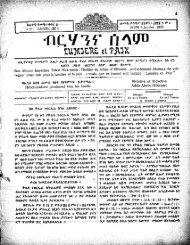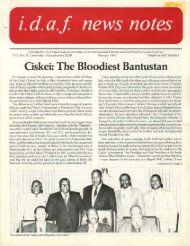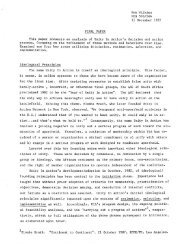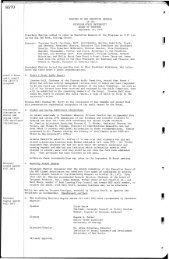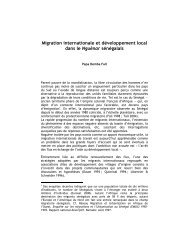Upper Egyptian Predynastic
Upper Egyptian Predynastic
Upper Egyptian Predynastic
You also want an ePaper? Increase the reach of your titles
YUMPU automatically turns print PDFs into web optimized ePapers that Google loves.
The <strong>Predynastic</strong><br />
of <strong>Upper</strong> Egypt
The <strong>Predynastic</strong><br />
of <strong>Upper</strong> Egypt
<strong>Upper</strong> <strong>Egyptian</strong><br />
<strong>Predynastic</strong><br />
Chronology
Initially, archaeologists developed a <strong>Predynastic</strong><br />
chronology for <strong>Upper</strong> Egypt that was broken into<br />
three phases: The Badarian, the Amratian, and the<br />
Gerzean.<br />
All of the phases are named for the specific<br />
predynastic type-sites: el-Badari, el-Amra, and el-<br />
Gerza.<br />
Badarian 4000-3800 BC<br />
Amratian 3800-3500 BC<br />
Gerzean 3550-3200 BC
WARNING:<br />
archaeology stuff ahead
Type-site: a site that is considered the model of a<br />
particular archaeological culture. Type-sites are<br />
often the first or foundational site discovered about<br />
the culture they represent.
Today, scholars divide the <strong>Upper</strong> <strong>Egyptian</strong><br />
<strong>Predynastic</strong> sequence into 4 primary phases:<br />
Badarian c.4400-4000 BC<br />
Naqada I c.4000 – 3500 BC<br />
Naqada II c.3500 – 3200 BC<br />
Naqada III<br />
(Protodynastic/Dynasty 0)<br />
Further detail had been injected to the chronology<br />
by adding sub phases – Naqada 1a, Naqada 1b,<br />
Naqada 2c, etc<br />
c.3200 – 3000 BC
The Badarian<br />
c.4400-4000 BC
The earliest predynastic<br />
culture in <strong>Upper</strong> Egypt<br />
is the Badarian<br />
Originally defined<br />
based on the<br />
excavations at El-Badari<br />
Dates back as early as<br />
ca. 5000 BC - making it<br />
contemporary with the<br />
Fayum <strong>Predynastic</strong>
Materials from both settlements and cemeteries<br />
indicate the cultivation of emmer wheat & barley<br />
Layers of sheep/goat droppings 20-30cm thick in<br />
some settlements are strong indications of<br />
domesticated animals<br />
Fishing and hunting also appear to be important<br />
activities in their subsistence economy
The Badarian is characterized by a distinctive type<br />
of black-topped brown, red rippled, or combed<br />
bowls<br />
Also considered characteristic are vessels with<br />
designs on the interior made by a burnishing<br />
pebble<br />
Rough ware ceramics are also considered typical of<br />
the Badarian
The Badarians used cosmetic materials for eye-<br />
paint, ground from mineral substances such as<br />
malachite<br />
These cosmetics were ground on decorative slate<br />
palettes<br />
slate palettes become one of the characteristic<br />
artifacts of the predynastic (especially in <strong>Upper</strong><br />
Egypt)
Badarian graves were oval or rectangular pits<br />
occasionally roofed with sticks or matting.<br />
Contained one or more loosely contracted bodies<br />
placed on their left sides, heads generally to the<br />
south.<br />
Strongly unequal distribution of grave goods both<br />
within and between cemeteries.
Naqada I<br />
c.4000 – 3500 BC
Naqada I begins a unbroken cultural continuum<br />
that flows directly into the Protodynastic/Dynastic<br />
This phase is defined by material derived almost<br />
exclusively from cemeteries.<br />
More specifically, Naqada I is almost exclusively<br />
defined by ceramics found in cemeteries
The graves of the Naqada I period are generally small<br />
and oval.<br />
Near the end of the Naqada I, the graves begin to<br />
exhibit an increase in grave goods.<br />
A limited number of larger, richly endowed tombs<br />
segregated in sectors indicates increasing social<br />
differentiation.
Naqada I Ceramics
While ceramics are the dominant material culture<br />
that comes out of Naqada I cemeteries, we also see<br />
examples of:<br />
Slate palettes<br />
Discoid mace heads<br />
Ivory or bone combs<br />
Flaked flint “fishtail” knives
Naqada I architectural remains take several forms:<br />
Round semi-subterranean mud and thatch<br />
hut-circles<br />
Rectangular and round thatched structures<br />
Post holes delineating wind screens
Naqada II<br />
c.3500 – 3200 BC
Nagada II is a period of significant socio-economic<br />
change and evolving institutions that eventually<br />
culminates in the dynastic period<br />
It is marked by evidence of contact with Southwest<br />
Asia<br />
Increasing interaction with communities in the<br />
Delta and Nubia also attest to increasing trade<br />
and/or colonizing efforts
As with Naqada I, Naqada II is very much<br />
characterized by its ceramics:<br />
Wavy handled pottery<br />
Rough ware<br />
“Fancy” forms<br />
Increase in boat decorations
While ceramics are the dominant material culture<br />
that comes out of Naqada II cemeteries, we also see<br />
examples of:<br />
Slate palettes<br />
mace heads<br />
figurines (male, female, animal)
The level of wealth within Late Naqada II graves<br />
seems to increases.<br />
Large rectangular graves lined with reed matting<br />
or wooden planks begin to appear in the<br />
Some of the elite tombs feature mud and mud-<br />
brick linings.<br />
In very rare cases, the tombs feature plastering and<br />
elaborately painted decoration.
Tomb 100 at Hierakonpolis<br />
2 m painted plaster scene<br />
suggests increasing social division, and the<br />
emergence of local rulers.
The later period of Naqada II is characterized by<br />
the development of a highly classed society with<br />
definite political entities; the polities/kingdoms of<br />
<strong>Upper</strong> Egypt
Hierakonpolis
Located 113 km north of<br />
Aswan and 650 km south of<br />
Cairo<br />
With over 50 identified<br />
settlements, industrial zones,<br />
and cemeteries, easily<br />
represents one of the most<br />
important <strong>Predynastic</strong> sites<br />
<strong>Predynastic</strong> occupation at<br />
Hierakonpolis continues<br />
uninterrupted from the<br />
Badarian to Dynasty 0
The <strong>Predynastic</strong> sites themselves are distributed in<br />
three major geographic zones:<br />
the alluvium<br />
the flat desert terraces<br />
the desert hills.
Hierakonpolis<br />
low desert
Hierakonpolis<br />
low desert
The Potter’s House<br />
HK29
HK11
Wadi Abu Suffian
HK11
During the <strong>Predynastic</strong>, special ecological factors<br />
made Hierakonpolis attractive to settlement and<br />
established a firm basis for its future urban growth:<br />
Concentration of several ecological habitats within a<br />
restricted area<br />
Abundance of fertile soil and raw materials<br />
Regular summer rainfall<br />
Existence of a now defunct Nile channel close to the<br />
border of the desert.
During the Naqada II period, Hierakonpolis<br />
became an industrial center:<br />
Pottery production<br />
Beer Brewing<br />
Specialized stone tool production
By the end of the Naqada II period, Hierakonpolis<br />
had become the capital of an <strong>Upper</strong> <strong>Egyptian</strong><br />
<strong>Predynastic</strong> kingdom<br />
Late Naqada II/Early Naqada III cemeteries show<br />
incredible social stratification<br />
Several cemeteries were dedicated to the local elite<br />
- most likely local rulers (proto-pharaohs)
PUNCHLINE<br />
<strong>Upper</strong> Egypt was a center of craft production<br />
(luxury goods, etc.)<br />
Interacted heavily with Lower Egypt through<br />
extensive trade networks (trade colonies)<br />
<strong>Upper</strong> Egypt was composed of a series of polities<br />
that were slowly consolidated into one political<br />
unit towards the end of the <strong>Predynastic</strong>
The End



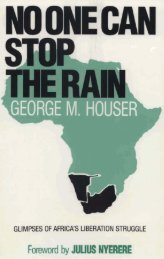

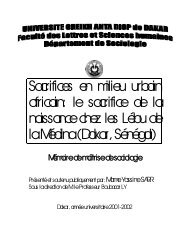
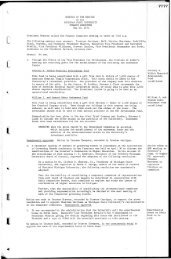


![Synthèse [6] DEFALL..INSTRAW.pdf - Matrix](https://img.yumpu.com/17880734/1/190x245/synthese-6-defallinstrawpdf-matrix.jpg?quality=85)
